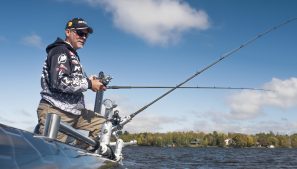
Trolling crank baits for walleyes is a great way to put fish in the boat. If you are new to trolling, there are a few basic things to know before you hit the water to ensure success.
One of the most important factors is putting your lures at the right depth to get bit. This is what is called the “feeding zone”. Before you put any lines in the water, drive around the area you want to fish and pay attention to where you are marking fish on your sonar.
If you are marking fish at 15 feet down over 25 feet of water, you may think that you want to run your lures at 15 feet, but chances are you won’t get bit. This is because walleyes tend to “feed up”, which means that their feeding zone is above where they are in the water column. Instead, try running your lures at 10 feet, for a better chance at getting a bite. If you are targeting fish that are tight to the bottom or relating to structure, you need to troll the lure right in front of their face to trigger a reactionary bite.
So how do you know where your lure is running in the water column? Each lure runs differently depending on the style and size of the bait. The amount of line you let out on a specific lure will determine how deep it will run. I like to use the Precision Trolling app to tell me how much line to let out to get it in the feeding zone.
If you need to run your lure deeper than it is designed to run on its own, you can put a weight in front of it, like an Off Shore Tackle Guppy Weight or an OR16 Pro Snap to gain more depth. Another way to get your lure deeper while fishing structure is to use lead core line. You can find information on using both lead core and weighting systems on the Precision Trolling app.
To spread lines out to cover more ground, I like to use the Off Shore Tackle OR12 Side Planers. Since these boards are perfectly ballasted, they run true in all fishing conditions. I place three rod holders on each side in the back of the boat. The rod with the “outside line” is placed in the holder closest to the bow. The “middle line” goes in the middle holder, and the “inside line” is in the holder closest to the stern.
To bring a fish in that hits on the outside line, let the middle and inside lines free spool so the boards drop back. You can then reel in the outside line, which will now be ahead of and out of the way of the other lines. To see how this is done you can watch this video: https://www.youtube.com/watch?v=GY1MkxQb6pA
Editors Note: If you have questions or comments on this or other articles of mine you may have read, contact me through the website The NextBite.TV










